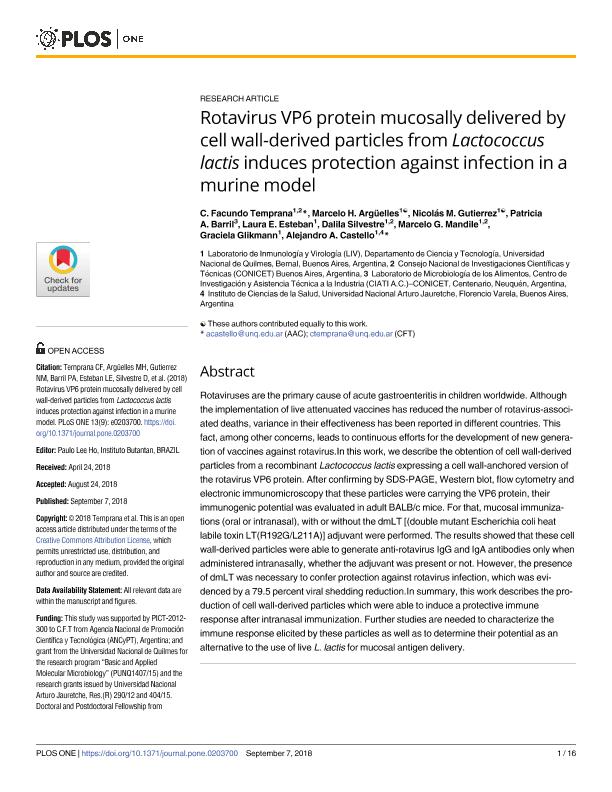Mostrar el registro sencillo del ítem
dc.contributor.author
Temprana, Carlos Facundo

dc.contributor.author
Argüelles, Marcelo Horacio

dc.contributor.author
Gutierrez, Nicolás Manuel

dc.contributor.author
Barril, Patricia Angelica

dc.contributor.author
Esteban, Laura Emilia

dc.contributor.author
Silvestre, Dalila

dc.contributor.author
Mandile, Marcelo Gastón

dc.contributor.author
Almallo de Glikmann, Graciela

dc.contributor.author
Castello, Alejandro Andrés

dc.date.available
2020-02-21T18:29:12Z
dc.date.issued
2018-09
dc.identifier.citation
Temprana, Carlos Facundo; Argüelles, Marcelo Horacio; Gutierrez, Nicolás Manuel; Barril, Patricia Angelica; Esteban, Laura Emilia; et al.; Rotavirus VP6 protein mucosally delivered by cell wall-derived particles from Lactococcus lactis induces protection against infection in a murine model; Public Library of Science; Plos One; 13; 9; 9-2018; 1-16
dc.identifier.issn
1932-6203
dc.identifier.uri
http://hdl.handle.net/11336/98292
dc.description.abstract
Rotaviruses are the primary cause of acute gastroenteritis in children worldwide. Although the implementation of live attenuated vaccines has reduced the number of rotavirus-associated deaths, variance in their effectiveness has been reported in different countries. This fact, among other concerns, leads to continuous efforts for the development of new generation of vaccines against rotavirus.In this work, we describe the obtention of cell wall-derived particles from a recombinant Lactococcus lactis expressing a cell wall-anchored version of the rotavirus VP6 protein. After confirming by SDS-PAGE, Western blot, flow cytometry and electronic immunomicroscopy that these particles were carrying the VP6 protein, their immunogenic potential was evaluated in adult BALB/c mice. For that, mucosal immunizations (oral or intranasal), with or without the dmLT [(double mutant Escherichia coli heat labile toxin LT(R192G/L211A)] adjuvant were performed. The results showed that these cell wall-derived particles were able to generate anti-rotavirus IgG and IgA antibodies only when administered intranasally, whether the adjuvant was present or not. However, the presence of dmLT was necessary to confer protection against rotavirus infection, which was evidenced by a 79.5 percent viral shedding reduction.In summary, this work describes the production of cell wall-derived particles which were able to induce a protective immune response after intranasal immunization. Further studies are needed to characterize the immune response elicited by these particles as well as to determine their potential as an alternative to the use of live L. lactis for mucosal antigen delivery.
dc.format
application/pdf
dc.language.iso
eng
dc.publisher
Public Library of Science

dc.rights
info:eu-repo/semantics/openAccess
dc.rights.uri
https://creativecommons.org/licenses/by-nc-sa/2.5/ar/
dc.subject
ROTAVIRUS
dc.subject
LACTOCOCCUS LACTIS
dc.subject
VP6
dc.subject.classification
Biotecnología relacionada con la Salud

dc.subject.classification
Biotecnología de la Salud

dc.subject.classification
CIENCIAS MÉDICAS Y DE LA SALUD

dc.title
Rotavirus VP6 protein mucosally delivered by cell wall-derived particles from Lactococcus lactis induces protection against infection in a murine model
dc.type
info:eu-repo/semantics/article
dc.type
info:ar-repo/semantics/artículo
dc.type
info:eu-repo/semantics/publishedVersion
dc.date.updated
2020-02-18T16:04:49Z
dc.journal.volume
13
dc.journal.number
9
dc.journal.pagination
1-16
dc.journal.pais
Estados Unidos

dc.journal.ciudad
San Francisco
dc.description.fil
Fil: Temprana, Carlos Facundo. Consejo Nacional de Investigaciones Científicas y Técnicas; Argentina. Universidad Nacional de Quilmes. Departamento de Ciencia y Tecnología. Laboratorio de Virologia; Argentina
dc.description.fil
Fil: Argüelles, Marcelo Horacio. Consejo Nacional de Investigaciones Científicas y Técnicas; Argentina. Universidad Nacional de Quilmes. Departamento de Ciencia y Tecnología. Laboratorio de Virologia; Argentina
dc.description.fil
Fil: Gutierrez, Nicolás Manuel. Universidad Nacional de Quilmes. Departamento de Ciencia y Tecnología. Laboratorio de Virologia; Argentina
dc.description.fil
Fil: Barril, Patricia Angelica. Consejo Nacional de Investigaciones Científicas y Técnicas; Argentina. Centro de Investigación y Asistencia Técnica a la Industria; Argentina
dc.description.fil
Fil: Esteban, Laura Emilia. Universidad Nacional de Quilmes. Departamento de Ciencia y Tecnología. Laboratorio de Virologia; Argentina. Consejo Nacional de Investigaciones Científicas y Técnicas; Argentina
dc.description.fil
Fil: Silvestre, Dalila. Consejo Nacional de Investigaciones Científicas y Técnicas; Argentina. Universidad Nacional de Quilmes. Departamento de Ciencia y Tecnología. Laboratorio de Virologia; Argentina
dc.description.fil
Fil: Mandile, Marcelo Gastón. Universidad Nacional de Quilmes. Departamento de Ciencia y Tecnología. Laboratorio de Virologia; Argentina. Consejo Nacional de Investigaciones Científicas y Técnicas; Argentina
dc.description.fil
Fil: Almallo de Glikmann, Graciela. Universidad Nacional de Quilmes. Departamento de Ciencia y Tecnología. Laboratorio de Virologia; Argentina
dc.description.fil
Fil: Castello, Alejandro Andrés. Consejo Nacional de Investigaciones Científicas y Técnicas; Argentina. Universidad Nacional de Quilmes. Departamento de Ciencia y Tecnología. Laboratorio de Virologia; Argentina. Universidad Nacional Arturo Jauretche; Argentina
dc.journal.title
Plos One

dc.relation.alternativeid
info:eu-repo/semantics/altIdentifier/url/http://dx.plos.org/10.1371/journal.pone.0203700
dc.relation.alternativeid
info:eu-repo/semantics/altIdentifier/doi/http://dx.doi.org/10.1371/journal.pone.0203700
Archivos asociados
